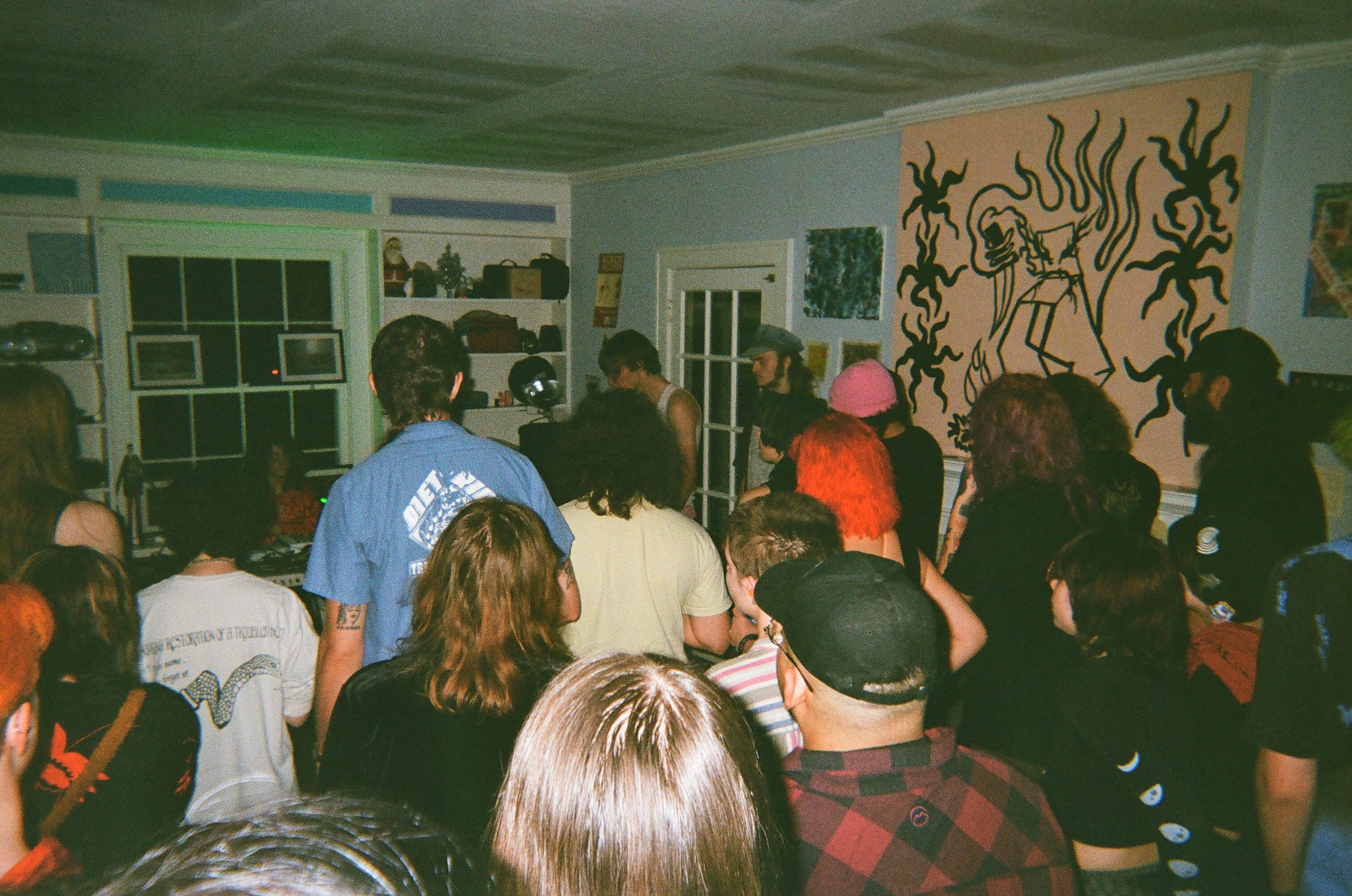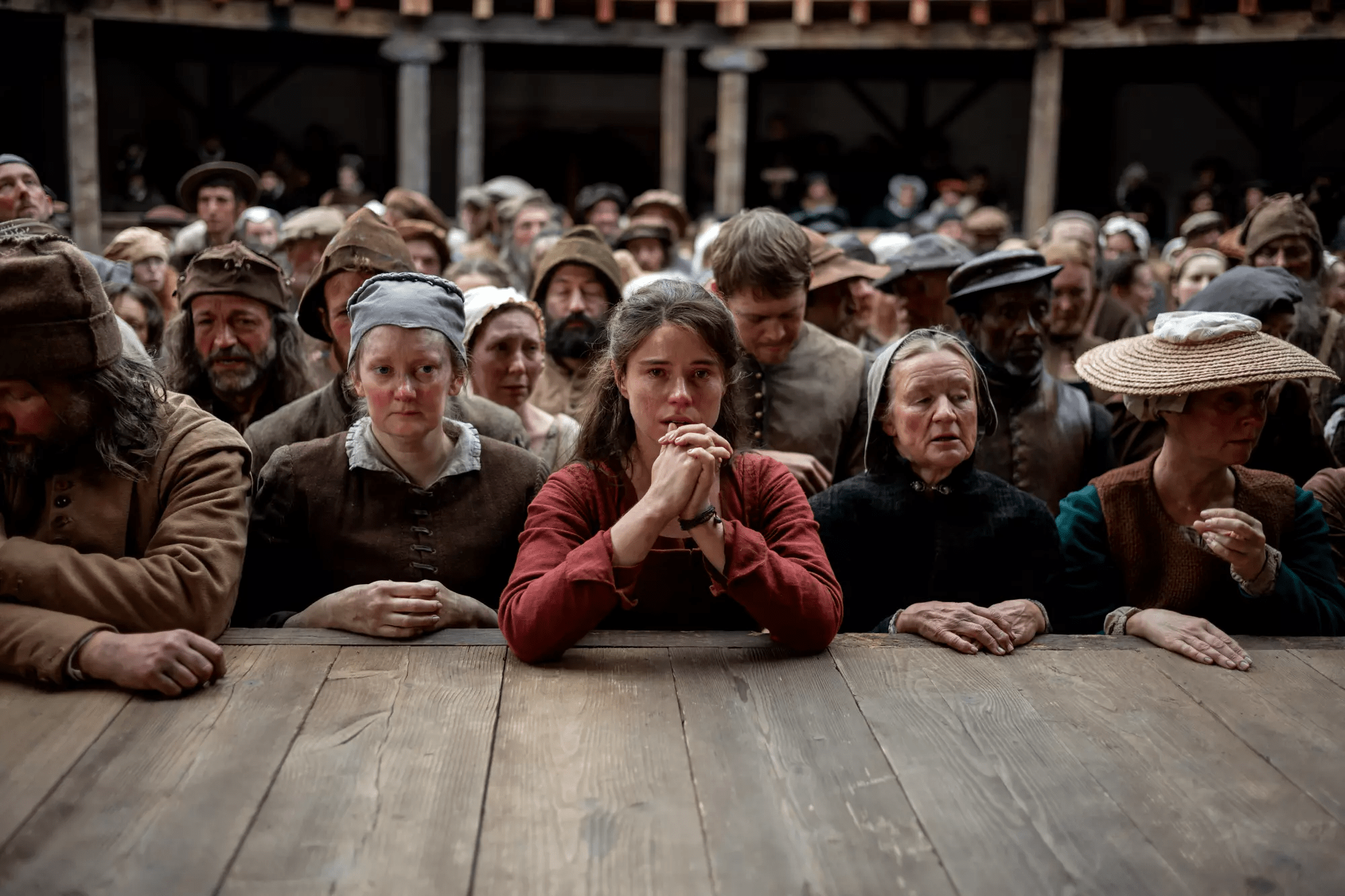Tulsa has no shortage of performance venues for a city its size: Cain's Ballroom, The Church Studio, Tulsa Performing Arts Center, LowDown, and a host of dive bars, to name a few. But in other less public haunts across the city, artists and musicians are creating alternative performance spaces that redefine the possibilities for experiencing art in Tulsa.
These spaces have one life during the day, then transform into intimate performance settings at night: basements turn into stages for local bands, homes become art galleries, porches host concert series. At any one of these shows, you could see your next favorite punk band, a stand-up comedian, multi-media artists, a classically-trained musician performing their favorite avant garde piece, or even get called up on stage yourself to share your own work.
Flying largely under the conventional events radar, this alternative model has persisted in Tulsa for decades, ebbing and flowing with the times. This particular moment is a pivotal one for spaces like these, which are uniquely vulnerable to shifting socioeconomic realities. Most often the project of one or two individuals, these venues can only exist as long as their owners are willing to invest time, money, space, and passion.
Vox Pop—a living-room-based event series run by Chris and Erin McCabe, featuring a potluck, a speaker, and a musical act for each show—just ended its run after eight years and nearly 70 shows as the McCabes move to focus more on family. The decade-old record label Cult Love has paused its house shows after six years of operation since one of its founders moved out of the house that served as the performance space. At the same time, newcomers like Trueson and Zia Daugherty’s Salon at the Parlour series, Eden Hemming and Brad Rose’s Bird House, Anne Pollard James’ Carson House, and racquetball-court-turned-concert-hall The Cave have all started to establish themselves as a new wave of private performance spaces, uniquely reflective of hyperlocal needs.
It’s not surprising that alternative art spaces are seeing a resurgence in a time of digital exhaustion and invasive capitalism. There are no economies of scale here: it’s impossible to fit more than a few dozen people in a house at once. There is no way to increase the price of admission without losing the intentionality and intimacy among organizers, attendees, and performers. There is no zero-sum competition between these venues, only collaboration and cross-pollination. And there are no virtual interactions, only very real ones.
The shapeshifting quality of these venues—home by day, performance space by night—makes it easier for them to exist financially. They can also allow for a wider range of types of art, since there isn’t a need to draw in a minimum crowd. Unlike bars or concert halls, they don’t need to book whatever act will bring the most bodies through the door so that they can make rent and cover expenses for the night.
And the spaces themselves are as diverse as their genre-pushing offerings. Venues like Barkingham Palace, Cult Love House, the Crawlspace, and the Chasement tap into a decades-old tradition of Tulsa house shows that stems from the DIY punk scene. Vox Pop, The Cave, Sperry Sounds, and the Owen Park Tiny Porch Concerts have staged more mainstream performances to appeal to a wider audience. The Parlour, ArtHouse Tulsa, Carson House, Queen Rose Art House, and the Bird House, among others, take the idea of a house-based venue beyond musical shows to include performance and installation art, classes, meet-ups, and other programming that creates a public space out of a private residence.
So what’s it like at a house-based show? I spoke with several of the organizers to get a better understanding of how these spaces operate and what they bring to the local arts ecosystem.
A place that feels like home
An event at an alternative space feels less like stepping into a typical bar or concert hall and more like exactly what it is: entering someone’s home. Crossing that threshold from Tulsa’s public space to an interior private abode immediately creates a sense of intimacy, family, and community.
At Cult Love, that sense of closeness came from the community nature of the space’s origins, as well as the physical size. Founded by Natty Gray, LoDrum, and George Christ a decade ago, Cult Love is primarily a record label that features punk, noise, and other less mainstream artists. (Their Cult Love & Friends Vol. 3: 10 Year Anniversary Edition cassette comes out May 26.) Inspired by the house show punk rock concerts they attended while growing up in Tulsa, Gray, LoDrum, and several other friends started throwing their own shows at their house in order to present the type of acts they wanted to see and to foster a sense of community among concert attendees.
When Gray moved into Cult Love’s most recent location six years ago, the project expanded from just concert shows to a full-blown art installation and community hub. Located next to Woodward Park, the house matches many of its neighbors from the outside: two stories, white siding, and a well-kept lawn. Inside, however, brightly colored murals from 19 local artists cover the walls and, during the years Cult Love was hosting performances, the two rooms closest to the entrance were generally kept free of furniture so they could double as a stage or DIY space during concerts.

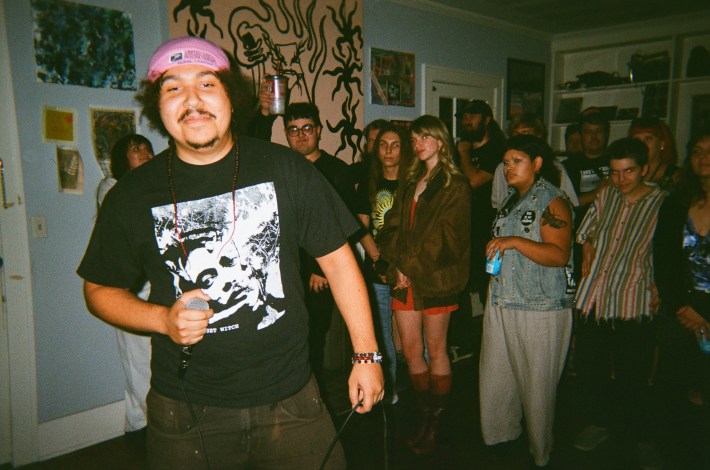
“There's a lot to be said about just going inside someone's home, [versus] if you're in a gallery space, which is just a concrete floor with concrete walls and you're just standing there,” LoDrum says. The furniture, small rooms, and decorations of an alternative space all help wash away the pretentiousness of the traditional white-walled gallery and encourage people to feel comfortable enough to talk with those standing next to them, even if they have never met before. Smaller than all but the tiniest coffee house venue, the Cult Love house offered a place where attendees couldn't help but bump into each other and start up a conversation. Further into the house, plenty of couches and seating invited guests to sit and chat in a relaxed atmosphere—a stark contrast to experiencing a punk rock or harsh noise act on a stage.
Hominess like this creates a sense of safety that provides a very real, very needed counterpoint to the day-to-day experience of many people who frequent the shows. Yjes Rondi has been throwing house shows for the past 20 years, 12 of which have been dedicated to her current venue, Barkingham Palace, a historic home near downtown Tulsa. Shows at her venue are about far more than music; her focus on creating safe and welcoming experiences comes out of her own experience going to shows as a young person.
“The first show I went to,” Rondi says, “my mom dropped me off—this was before having a phone was a thing—and she asked this random dude who was probably 22 or something what time she should pick me up at. That person stuck by me for most of the night, introduced me to people, and made sure I was safe. I never forgot how important that moment was and it probably formed everything for me.”
Walking up to Barkingham, the anxiety of going into an unknown space quickly disappears as you pass through Rondi’s front yard garden and into a house that she characterizes as “grandma-core through and through.” The venue has a steady stream of concerts and events throughout the year—punk, hardcore, or rock musical performances, sewing workshops, book drives for libraries in DIY spaces, silkscreen workshops, and other DIY activities—all of which cater to an all-ages audience, with donation-based admission prices to ensure accessibility. But the events are only one part of Rondi’s larger goal.
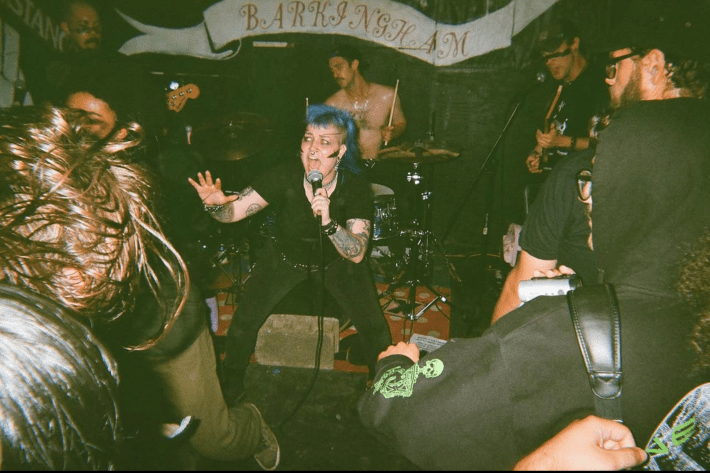

“I've had a lot of younger people tell me, ‘I've never been in a house like this. I feel so safe here,’” she says. “This space is built on community and love, so I think it just radiates that. I make sure that when people come in there, they know that they can get in the fridge and get whatever the fuck they want. In the bathroom, we have pregnancy tests, condoms, Narcan, and harm reduction things, Plan Bs, things like that. I think that makes people really feel safe once they see that stuff, because they know that it's a come-as you-are sort of situation and whatever you need, we can make sure you get it.”
In other words, the casual, homey vibe isn’t just happenstance; it’s fully intentional, creating an enveloping sense of comfort, protection, and community.
The not-so-secret invitation
That experience starts even before you walk in the door. Going to an alternative space show is one part scavenger hunt, one part night out at the speakeasy, and one part hanging out at a good friend’s house. You can’t stumble across one of these spaces in the same way that you would run across a bar or a concert hall.
Events aren’t invitation-only per se, but they do require effort on the part of the attendee. As Gray puts it, “they immediately ask a level of unusual engagement [since] you have to literally contact us to come.” Some of the more visible venues have a set calendar advertised through social media accounts; others lean more heavily into flyering and word of mouth to bring in an audience. But no matter how someone finds out about a show at an alternative space, they usually need to reach out and connect with the venue beforehand for details on how to show up.
These initial barriers to entry give alternative spaces the allure of an underground club frequented by an in-crowd. However, while attendees do have to be in the know or put themselves out there to some degree, these venues have the explicit goal of being open and welcoming. In practice, the steps for attendance serve as a kind of healthy friction, intended not so much to keep people out as to ensure that the people who do show up are invested in creating a community.
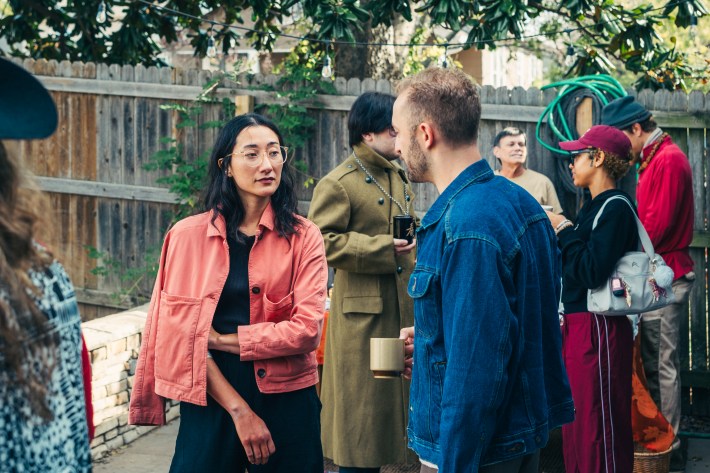

Once inside the space, setting the right expectations is key. The organizers at alternative spaces will often greet people at the door with a brief outline about etiquette and information about who to come to if they need assistance. Trueson and Zia Daugherty, for instance, announce a clear set of rules at the beginning of each of their Salons: anyone is welcome to share their art by standing on a (literal) soapbox for a maximum of three minutes, and when someone is on the box the audience needs to be quiet and attentive until time runs out. Though these are fairly strict rules, visitors readily adhere to them. Trueson says, “There's this immediate question of: ‘What are your rules? I have to humble myself. I'm in somebody else's space.’”
Some of these expectations have to do with caring for the venue itself. Whereas there’s a clear divide between staff and patrons in a bar or gallery, that line is blurry at best in alternative spaces. Attendees need to be not just respectful of the showrunners’ space, but responsible for it as well. At Barkingham Palace, guests are often given small tasks in a way that builds a communal sense of shared responsibility. “I can't speak for everybody, obviously,” says Rondi, “but when I was younger and I was given responsibility in places that I felt like I had no business having any responsibility, it made me feel so much more a part of that space.”
Putting the show together
Just as they appeal to people who are looking for a different experience than they’d get in a mainstream arts venue, house-based art spaces tend to present artistic efforts that don’t conceptually fit in at more traditional locations.
Concerts are a mainstay, usually featuring up-and-coming local or regional bands within niche genres, though sometimes national acts with a small, dedicated following also make it onto the bill. At the Crawlspace—a relative newcomer to the Tulsa house show venue list, founded in 2024 and inspired by venues like Barkingham and Cult Love—the proprietor, Brutus, books shows that might not be a fit at other venues.1 He started the Crawlspace after putting on a house concert for out-of-town friends whose band he was unable to book on a local stage. That first show was a success, and Brutus continued booking friends when they came through town.
As he continues to expand shows at the all-ages, pay-what-you-can Crawlspace, Brutus wants to push the type of programming that can exist in these spaces. “I look at it as a model where we innovate and do weird, different things,” he says. “I very much see it as a testing ground for different ideas and concepts.”
Some events, like the Daughertys’ Salon series, simply defy categorization. Held at regular intervals throughout the year in the couple’s midtown home (known as The Parlour), the format has been wildly successful, with the house often filling to capacity. As with many other alternative spaces, The Parlour’s offerings evolved out of a perceived gap in the local art scene—in this case, a lack of opportunities to hear classical or acoustic music in a close-up setting with others who were dedicated to focused, attentive listening.
What started as a simple idea quickly morphed into a unique open mic-style event that brings in artists of any medium. Concerned about people’s ability to stay engaged over the course of a quiet, hour-and-a-half performance, the Daughertys decided to add time at the beginning of the show for anyone to get up and share their artistic practice: poets, visual artists, musicians, and creative psychics to name a few.
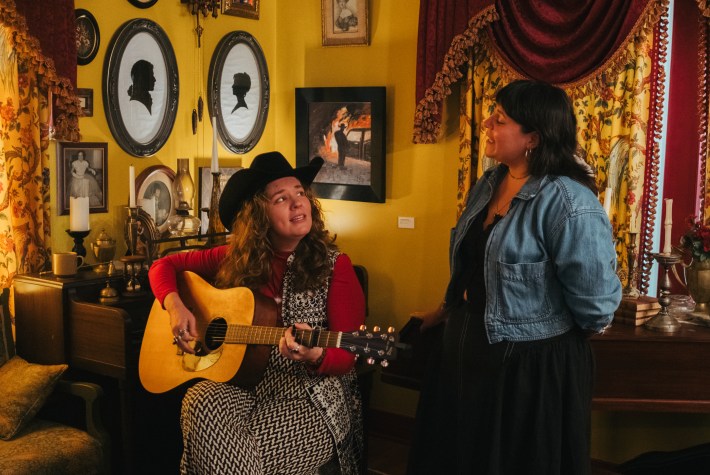
Even the featured performer slot has evolved at the Salon. The Daughertys initially asked a classical musician to perform a Bach piece as part of their vision for the event, but the musician opted for more contemporary pieces instead. The turnaround was a revelation for the couple: their mission wasn’t just to bring a particular type of music into the space, but also to let the musicians express themselves and their own approach to their work. Over the subsequent Salons, this freedom has ranged from bassist Jordan Hehl playing a drone piece to local singer-songwriters like Mallory Eagle, Kalyn Fay, and John Ferrell sharing new, in-progress songs—the kind of performances you can’t hear musicians like this do anywhere else in Tulsa.
The Salons inspire both the artists involved and the audiences who get to witness them. And access to inspiration is a big part of the goal, as Trueson describes it. “I hope that when some young artist—or maybe some old artist—is in Tulsa and they feel that there's no space for them … to be expressive and, you know, be weird,” he says, “that they would come to a Salon and see Parker Wayne do a performance art piece and realize, oh my gosh, there's other people that are doing this. I'm not alone. And I can also be my most authentic, expressive self and can live that art life because I'm surrounded by people that are doing it right here in somebody's living room.
“It's so accessible,” he says. “It doesn't take anything other than to just do it.”
A place to talk freely
Alternative venues not only foster creative authenticity, chance connections between like-minded people, and a shared investment in the space. They also facilitate important dialogues that are often absent from the larger discourse: take painter Anne Pollard James’ Carson House, located in a residential neighborhood just south of downtown Tulsa, as a particularly salient example.
Created after the peak of the pandemic when Pollard James was trying to find a new place to host a yoga class, Carson House—which she owns—quickly became a full-fledged community art space for women, where open conversations that aren’t historically available for public consumption can happen. In addition to yoga classes, life drawing sessions, and regular gallery shows, the house hosts menopause workshops that create space for women to discuss and support each other around an important aspect of healthcare that has long gone unspoken not just in public discourse, but in healthcare itself.
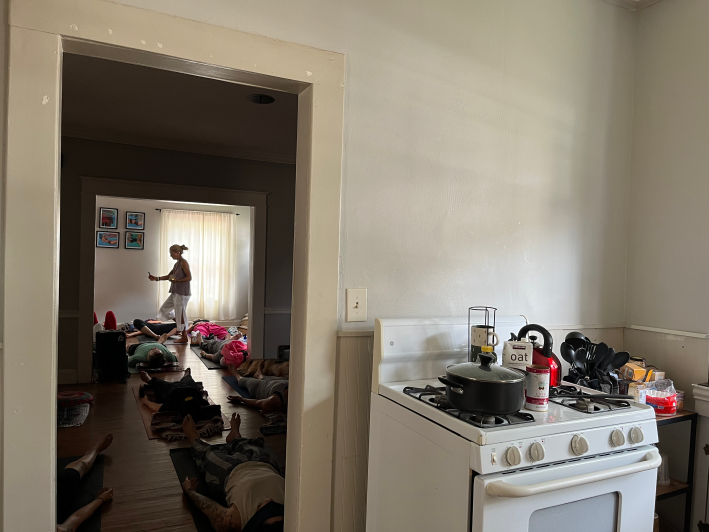

These types of events can happen more readily and frequently in alternative spaces than they can in public spaces, addressing critical needs of the community while building a support network for participants. Rondi puts this very succinctly: connections formed in alternative spaces, she says, are all about “being seen; knowing that your experiences are not only valid and your emotions are valid, but that somebody can either relate to you or empathize with you; and building vulnerable moments that build and strengthen community.”
Community support
Alternative spaces are a labor of love. They rarely break even and are often funded by organizers’ day jobs, donations, or keeping costs low through a DIY mentality. They’ll never net a huge profit. What they will do is foster the freedom to develop artistic practices that push past the predictable, build community, and make life worth living.
The individuals that run these spaces spend hundreds of hours each year promoting their events, booking acts, setting up, and cleaning their spaces after shows to create experiences that they don’t find anywhere else—in other words, to build the world that they want to see. The long hours and significant resources that these spaces require also mean that the projects can quickly shutter when the owners focus on other efforts, no longer want to invest their own money, move locations, or become burnt out. But new ones rise up to fill the gaps.
Tulsa’s creative community thrives in these spaces because of the freedom they provide to anyone who takes the initiative to reach out and engage. They offer a structure for artists and audiences to create their own narratives and explore their own identities while witnessing the same from others. It’s a model that extends beyond dominant narratives about what Tulsa’s artistic spaces should or shouldn’t be and into the realm of individualized, localized communities. Rondi sums up the ethos of alternative spaces perfectly: “They were all just homes that had good people living in them who wanted to make sure that everybody who walked through that door knew that they were cared about.”
Footnotes
- Editor's note: Shortly after publishing this story, we learned that the Crawlspace has ceased operations—which speaks to how tough it can be to keep spaces like this going.Return to content at reference 1↩
